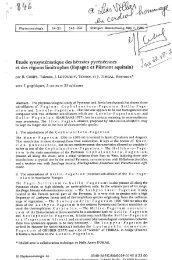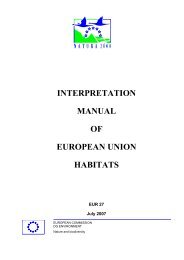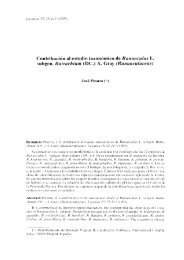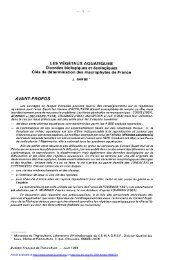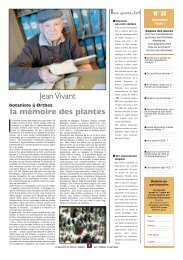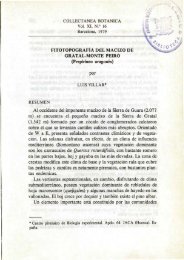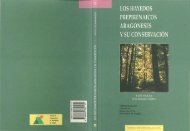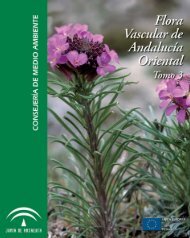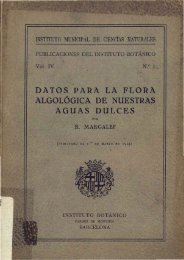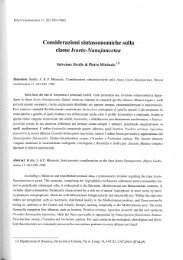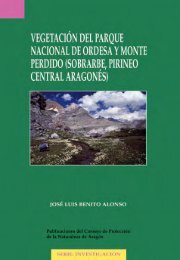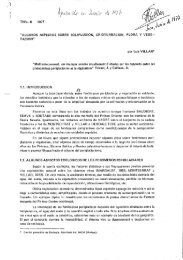Catálogo florístico del Parque Nacional de Ordesa y Monte Perdido ...
Catálogo florístico del Parque Nacional de Ordesa y Monte Perdido ...
Catálogo florístico del Parque Nacional de Ordesa y Monte Perdido ...
Create successful ePaper yourself
Turn your PDF publications into a flip-book with our unique Google optimized e-Paper software.
2. <strong>Catálogo</strong> <strong>florístico</strong> <strong>Catálogo</strong> <strong>florístico</strong> <strong><strong>de</strong>l</strong> <strong>Parque</strong> <strong>Nacional</strong> <strong>de</strong> Or<strong>de</strong>sa y <strong>Monte</strong> <strong>Perdido</strong><br />
Morera, 955 m, JLB. BH6123: [E] Cabecera <strong><strong>de</strong>l</strong> Valle,<br />
1690-1770 m, JLB & IST (R272569). YN3925: [T] sierra <strong>de</strong> las<br />
Cutas, Balcón <strong><strong>de</strong>l</strong> Rey, 2000-2150 m, EBR (107589). YN3631:<br />
[B] Umbría <strong><strong>de</strong>l</strong> Turbón, 1400 m, JLB (R272596).<br />
SECT.: B O T A E. ALT.: 955 – 2050 m. G. Med. W<br />
En general, gusta <strong>de</strong> terrenos pedregosos con<br />
cierto período seco. Ononi<strong>de</strong>talia striatae, Aphyllanthion.<br />
E.<br />
1123. Narcissus pseudonarcissus L.<br />
CITAS PREVIAS: PITARD, 1907: 98; ARBELLA, 1984.<br />
LOC.: BH52: [A] Sierra Custodia, 2040 m, (ARBELLA, op. cit.),<br />
P00658. BH5830: [P] Balcón <strong>de</strong> Pineta, 2100 m, PM (206278).<br />
BH6529: [C] Pietramula, 1900 m, R. Jiménez (310693).<br />
YN3328: [B] Fenés, J.A. Villacampa. YN3533: [B] Salto <strong><strong>de</strong>l</strong> Pich,<br />
1550 m, JLB & LV (6293).<br />
CUTM 1×1: BH52; BH5830; BH6529; YN3328; YN3532; YN3533; YN3831.<br />
SECT.: B A P C. ALT.: 1450 – 2100 m. G. Plurirreg. (Alp.-Atl.).<br />
Salpica aquí y allá pastos supraforestales <strong>de</strong><br />
distinto tipo, herbazales antiguamente segados,<br />
etc. Mesobromion, Seslerietalia, etc. RR.<br />
1124. Narcissus alpestris Pugsley<br />
N. moschatus (L.) Baker sensu D.A. Webb, N. cernuus Roth<br />
CITAS PREVIAS: PITARD, 1907: 95; ARBELLA, 1988; ALDEZÁBAL,<br />
1997, ut N. cernuus.<br />
LOC.: BH5815: [A] ctra. <strong>de</strong> Añisclo Km 9-10, 1000 m, DGG<br />
(702781). BH5521: [A] Cuello Arenas, 1900 m, DGG (39396).<br />
BH6111: [A] entrada al valle <strong>de</strong> Añisclo, 800 m, DGG (1093).<br />
BH6520: [E] Revilla, camino a los miradores <strong>de</strong> la Loresa,<br />
1200-1250 m, JLB (R272460). BH6130: [P] La Larri, 1500-1550<br />
m, JLB (R272494). BH7223: [B] pista <strong>de</strong> Rifarrera, 1200 m, R.<br />
Jiménez (284193). YN3624: [T] Peña Pillera, 1200 m, J. Villacampa.<br />
YN3434: [B] Ordiso, 1540 m, JLB & LV (5993).<br />
SECT.: B O T A E P. ALT.: 700 – 2160 m. G. Pir.<br />
En zonas bajas lo vemos en claros <strong>de</strong> bosque<br />
pisoteados, pero prospera mejor en los pastos.<br />
Mesobromion, Nardion. Fr.<br />
190<br />
CI. DIOSCOREACEAE<br />
1125. Bor<strong>de</strong>rea pyrenaica Bubani & Bordère ex<br />
Miégev.<br />
Dioscorea pyrenaica Bubani & Bordère ex Gren.<br />
CITAS PREVIAS: CHOUARD, 1928: 959; QUÉZEL, 1956; FERNÁNDEZ<br />
CASAS, 1970c, 1972; MONTSERRAT, 1973: 61; RIVAS MARTÍNEZ,<br />
1977; MONTSERRAT, 1980: 73; ARBELLA, 1984, 1988; VILLAR &<br />
MONTSERRAT, 1990: 719; RIVAS MARTÍNEZ & al., 1991; GARCÍA<br />
GONZÁLEZ, 1993; BENITO & al., 1995b: 444; ALDEZÁBAL, 1997.<br />
LOC.: BH5626: [O] Collado <strong>de</strong> Góriz, 2280 m, DGG (103993).<br />
BH5930: [P] Circo <strong>de</strong> Pineta, 1740-1800 m, PM & LV (147082).<br />
BH6318: [E] Castillo Mayor, 1750 m, JVF (372590). BH6029: [P]<br />
hacia La Larri, 1320-1400 m, GM (923880). BH6030: [P] senda<br />
<strong>de</strong> Montaspro, 1860-1900 m, JLB (213993). YN3832: [B] bco.<br />
<strong>de</strong> Lapazosa, 2000 m, JLB & al. (189495). YN4125: [O] Punta<br />
Acuta, 2050 m, JLB & al. (190797).<br />
SECT.: B O V A E P C. ALT.: (1320)1550 – 2410(2500) m. G. Pir. C.<br />
PROTECCIÓN: ARA: IV.<br />
Se trata <strong>de</strong> un género endémico <strong><strong>de</strong>l</strong> Pirineo<br />
cuyos parientes más próximos viven en África y<br />
América. Esta planta fue <strong>de</strong>scrita para la ciencia<br />
con ejemplares recolectados en Otal (Bujaruelo) y<br />
Pineta (cf. Miégeville, Bull. Soc. Bot. France 13:<br />
374, 1886); <strong>de</strong> hecho, tiene algunas <strong>de</strong> sus mejores<br />
poblaciones en el <strong>Parque</strong> y cercanías. Recientemente<br />
Rafael Vidaller la ha encontrado en la<br />
solana <strong><strong>de</strong>l</strong> Ten<strong>de</strong>ñera, en el barranco <strong><strong>de</strong>l</strong> Infierno,<br />
primera localidad en la cuenca <strong><strong>de</strong>l</strong> Gállego, siendo<br />
su límite occi<strong>de</strong>ntal absoluto <strong>de</strong> distribución.<br />
En el valle <strong>de</strong> Or<strong>de</strong>sa se ha recolectado a<br />
1400 m y en Pineta a 1300, sin duda las localida<strong>de</strong>s<br />
más abisales <strong><strong>de</strong>l</strong> Pirineo; la inversión térmica<br />
pue<strong>de</strong> se la causante <strong>de</strong> dicho <strong>de</strong>scenso altitudinal.<br />
GARCÍA GONZÁLEZ (1993) en su tesis doctoral<br />
ha <strong>de</strong>scubierto aspectos muy singulares <strong>de</strong> esta<br />
especie. Así, es la única planta herbácea europea,<br />
junto con su congénere B. chouardii, capaz <strong>de</strong> vivir<br />
más <strong>de</strong> 300 años (GARCÍA & ANTOR, 1995a). También<br />
se trata <strong>de</strong> la única especie europea polinizada<br />
por hormigas (mirmecofilia), siendo éstas<br />
capaces <strong>de</strong> discriminar con un alto grado <strong>de</strong> fiabilidad<br />
el polen fértil <strong><strong>de</strong>l</strong> estéril (GARCÍA & ANTOR,<br />
1995b).<br />
Coloniza las gleras calizas, principalmente<br />
subalpinas; <strong>de</strong> forma más esporádica la vemos en<br />
grietas <strong>de</strong> roca calcárea. Aquilegio-Bor<strong>de</strong>reeteum,<br />
Saxifragion mediae. Fr.<br />
1126. Tamus communis L.<br />
LOC.: BH5817: [A] San Úrbez, hasta gran tejo, 950-1150 m, PM<br />
(435675). BH6111: [A] zona baja <strong><strong>de</strong>l</strong> Cañón, 700 m, EBR (31991).<br />
BH6420: [E] Revilla, camino a los miradores, 1200-1240 m, JLB.<br />
YN3726: [T] fuente <strong>de</strong> la Lloceta, 1260 m, JLB.<br />
SECT.: T A E. ALT.: 700 – 1400 m. G. Plurirreg. (Med.-Atl.).<br />
Se queda en la zona baja <strong>de</strong> Or<strong>de</strong>sa, Añisclo y<br />
Escuaín. Forma parte <strong>de</strong> la orla herbácea más o<br />
menos húmeda <strong>de</strong> quejigales y carrascales. Prunetalia<br />
spinosae. R.<br />
CII. IRIDACEAE<br />
1127. Iris foetidissima L.<br />
LOC.: BH6014: [A] zona baja <strong><strong>de</strong>l</strong> Cañón, 800 m, LV (138082).<br />
CUTM 1×1: BH6014; BH6111.<br />
SECT.: A. ALT.: 750 – 800 m. G. Plurirreg. (Med.-Atl.).<br />
Otra <strong>de</strong> esas plantas <strong>de</strong> tierra baja que encuentran<br />
refugio en Añisclo como disyunción septentrional<br />
(ATLAS II: 444). Sólo se ha visto en la<br />
cunetas húmedas <strong>de</strong> la carretera. RRR.<br />
1128. Iris latifolia (Mill.) Voss<br />
I. xiphioi<strong>de</strong>s Ehrh.<br />
CITAS PREVIAS: PITARD, 1907: 95; CHOUARD, 1928: 962; LOSA &<br />
MONTSERRAT, 1947: 182; ARBELLA, 1988; ALDEZÁBAL, 1997.<br />
LOC.: BH5819: [A] Cañón <strong>de</strong> Añisclo, 1350 m, LV. BH5425: [O]<br />
Circo <strong>de</strong> Soaso, 1750 m, LV (408770). BH5930: [P] Circo <strong>de</strong><br />
Pineta, 1700-1750 m, PM & <strong>de</strong> Retz (429275). BH6921: [P]<br />
Portillo <strong>de</strong> Tella, 2060-2250 m, PM & LV (571186). BH6132: [P]<br />
Feixa Castiecho, 1810-2000 m, LV. YN3427: [B] entre bcos. <strong>de</strong><br />
las Comas y el Cebollar, 2140-2200 m, LV. YN3831: [B] bco. <strong>de</strong><br />
J.L. Benito Alonso – Institut d’Estudis Iller<strong>de</strong>ncs (2006)



